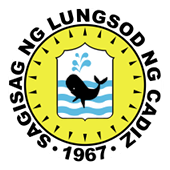CORPORATE PROFILE

CADIZ CITY
Cadiz City is a 1st Class Component City and is partially urban. It has a total of 22 Barangays. It is one of five chartered cities and one of the principal ports on the island where most of the country’s sugar is grown and refined and where fishing is a major industry.
VISION
Cadiz, a gateway and premier city with a diverse and globally competitive economy that promotes inclusive sustainable growth, productive ecosystem, disaster-resilient communities and infrastructures led by accountable and effective governance under the guidance of (the) Almighty God.
MISSION
We aim to strengthen the city’s fiscal management system, promote people’s active participation in community organization and decision-making process and develop a culture of cooperation from among the major stakeholders the implementation of economic development programs and sustainable delivery of basic services towards a sound and progressive economy
Geographical Location
Cadiz City is located at the northern tip of Negros Occidental, 65 kilometers away from Bacolod City which is the capital city of the Province of Negros Occidental. It is bounded on the north by the Visayan Sea, on the east by the City of Sagay, on the west by the Municipality of Manapla, on the southwest by the City of Victorias, and on the south by the City of Silay. It is located within the geographical coordinates of 10.8060° N, 123.2139° E.
Topography
The city has a land area of 516.50 square kilometers as per data of the DENR and DBM. It has 22 barangays, 10 of which are in the Poblacion and 12 are outside the city proper. The city has a wide range of plain that serves as its economic and urban centers. It extends three to five kilometers from its coastline up to the agricultural zone of the city. Its slopes vary up to a maximum of 3%. The predominant terrain of the city is rolling which is suitable for agricultural farming. The maximum elevation of the city reaches over 1000 meters and is situated in the Marapara Range.
Six rural Barangays of the city have forested areas which form part of the Northern Negros Reserve and later on declared as National Park. These six barangays are Caduha-an, Mabini, Magsaysay, V.F. Gustilo, and C.S. Villacin. The forest land comprises 16.84% of the total area of the city.
The soil classification of the city is clay loam. Its climate is Type “A” using the system introduced by Pedro P. Hernandez of the Philippine Atmospheric, Geographical and Astronomical Services Association (PAGASA) wherein the analysis of the climate is based on the ratio of the number of dry and wet months. Type “A” is the wettest climate classification among the eight (8) types.
The city has seventeen (17) major rivers, namely: Sicaba, Talaba-an Daku, Talaba-an Diotay Tinampa-an, Hitalon, Lagasan, Manara, Dinaldangan, Hamticon, Hiyang-hiyang, Pacul, Sewahon, Iglanggam, Piyok, San Antonio, Nabinay and Dalayapan. Three (3) major rivers traverse the Urban Area, these are Hitalon, Tinampa-an and Talaba-an Diotay.
Registered Voters: 92,674
Population: 157,438
Climate
Climate in Cadiz City is favourable having wet and dry months adopting the Pedro P. Hernandez system of climate analysis.

About
Contact
- PNP HOTLINE – 0998-178-2240
- PNP HOTLINE – (034) 4930-166
- DRRMO HOTLINE – 0909-140-6322
- DRRMO HOTLINE – (034) 493-1787 / (023) 4354-639
- CITY HEALTH OFFICE HOTLINE – (034) 4931-772 / 4450-117
